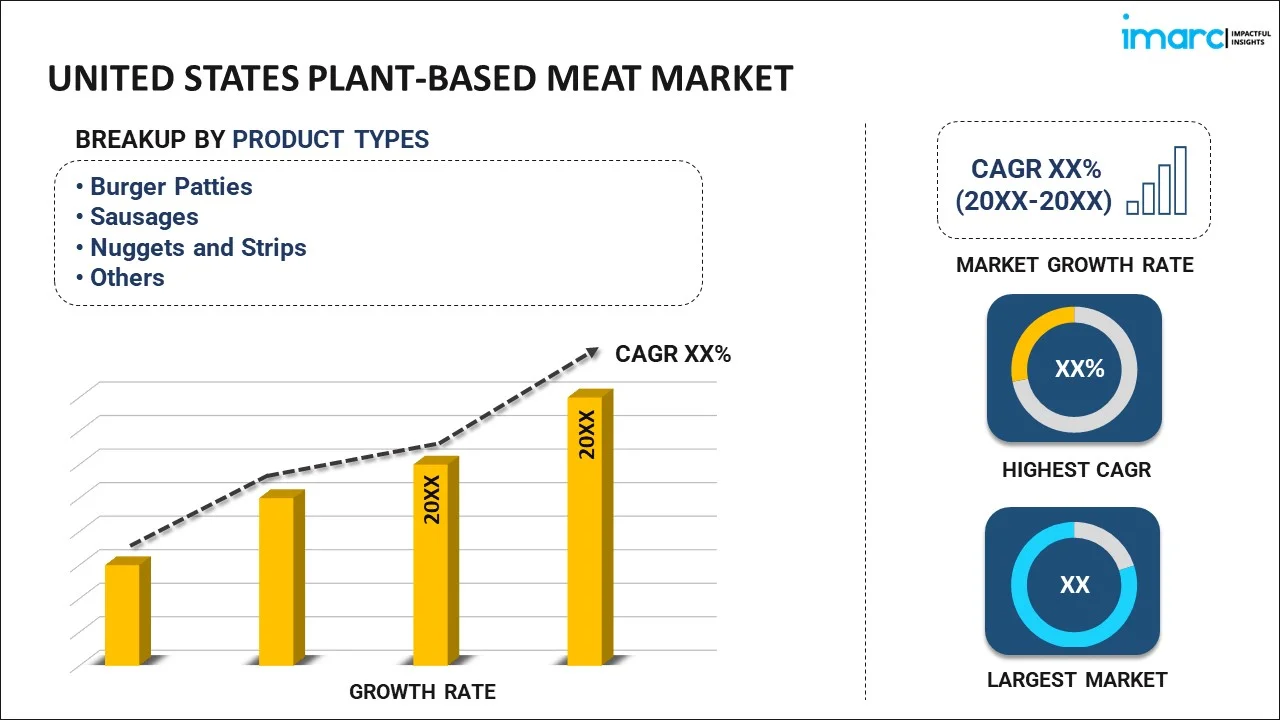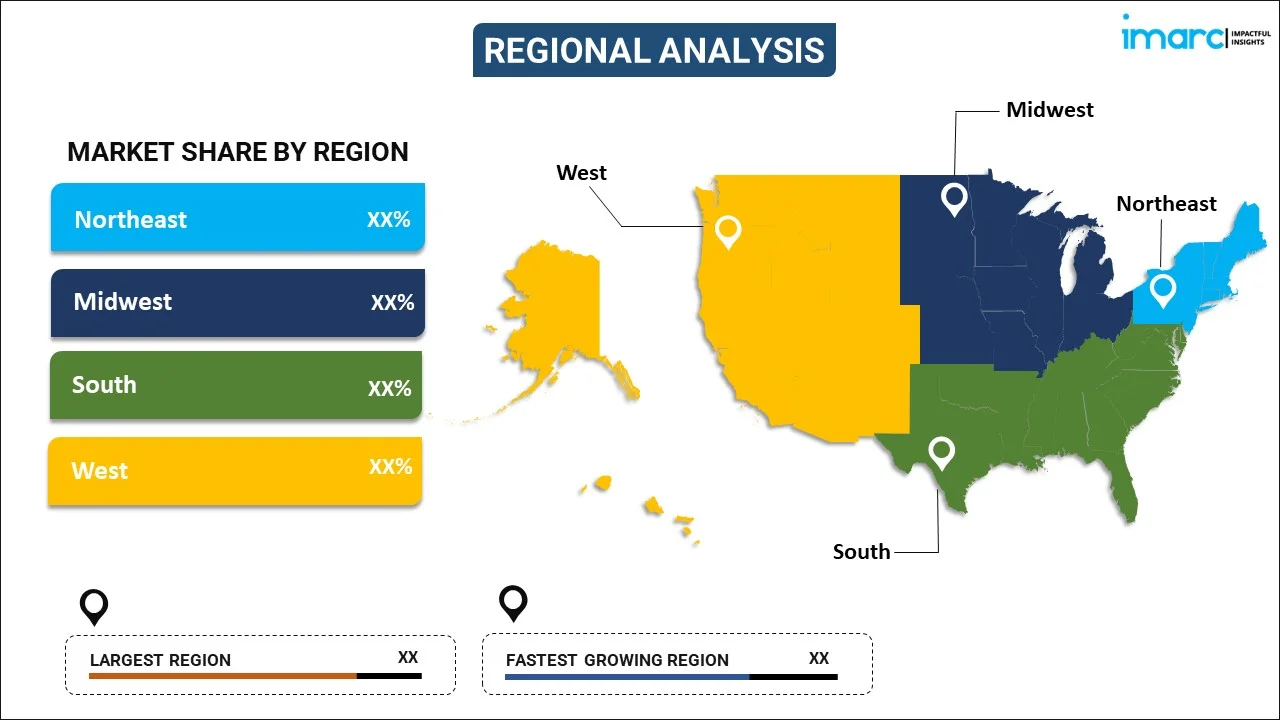
United States Plant-Based Meat Market Report by Product Type (Burger Patties, Sausages, Nuggets and Strips, Ground Meat, Meatballs, and Others), Source (Soy, Wheat, Peas, and Others), Meat Type (Chicken, Beef, Pork, and Others), Distribution Channel (Restaurant and Catering Industry, Supermarkets and Hypermarkets, Convenience and Specialty Stores, Online Retail), and Region 2025-2033
Market Overview:
The United States plant-based meat market size reached USD 3.4 Billion in 2024. Looking forward, IMARC Group expects the market to reach USD 18.9 Billion by 2033, exhibiting a growth rate (CAGR) of 21.2% during 2025-2033. The rising awareness about the health and wellness concerns associated with the product, growing need for environmental sustainability, increasing ethical and animal welfare considerations, advancements in food technology resulting in improved taste and texture of plant-based meat, and culinary diversity represent some of the key factors driving the market.
|
Report Attribute
|
Key Statistics
|
|---|---|
|
Base Year
|
2024 |
|
Forecast Years
|
2025-2033
|
|
Historical Years
|
2019-2024
|
| Market Size in 2024 | USD 3.4 Billion |
| Market Forecast in 2033 | USD 18.9 Billion |
| Market Growth Rate (2025-2033) | 21.2% |
Plant-based meat, also referred to as meat alternatives or meat analogs, is a type of food product designed to replicate the taste, texture, and appearance of traditional animal-based meat using ingredients derived from plants. This innovative approach to food production aims to provide consumers with an alternative protein source that aligns with vegetarian, vegan, and environmentally conscious diets. Plant-based meats are crafted from a variety of plant-derived ingredients such as soy, peas, wheat, and mushrooms, among others. These ingredients undergo processing techniques that involve blending, shaping, and sometimes even coloring to closely resemble the sensory experience of consuming animal meat. The resulting products can range from burgers and sausages to nuggets and ground meat substitutes.
United States Plant-Based Meat Market Trends/Drivers:
Growing awareness about the health benefits associated with plant-based diets is a key driver. Due to this, consumers are increasingly seeking alternatives that offer lower cholesterol, reduced saturated fat, and fewer calories compared to traditional meat. Plant-based meats often provide similar protein content without some of the health drawbacks of animal-based products. Additionally, the pressing need to mitigate climate change and reduce the environmental impact of food production has garnered significant attention. Plant-based meats, with their lower carbon footprint, reduced land and water usage, and minimized deforestation, align with consumer values of sustainability and eco-consciousness. Other than this, concerns for animal welfare are prompting consumers to explore cruelty-free options. Plant-based meats offer an appealing alternative for those who wish to enjoy the taste and texture of meat without contributing to animal suffering. Besides this, the plant-based meat market is diversifying its product range, offering an array of choices such as burgers, sausages, nuggets, and even plant-based seafood. This culinary diversity is attracting a wider audience, including flexitarians who seek to reduce meat consumption without sacrificing taste. In line with this, celebrity endorsements, media coverage, and social media influence are significantly contributing to the popularity of plant-based diets and meat alternatives. High-profile individuals and influencers advocating for these products are increasing their visibility and acceptance among consumers. Furthermore, plant-based meats are becoming increasingly available in mainstream supermarkets and restaurants, making them more accessible to consumers. This integration into everyday food channels is playing a crucial role in driving market growth. Moreover, advances in food technology have led to remarkable improvements in the taste and texture of plant-based meats. Products are becoming more indistinguishable from animal-based counterparts, appealing to a broader consumer base.
United States Plant-Based Meat Industry Segmentation:
IMARC Group provides an analysis of the key trends in each segment of the United States plant-based meat market report, along with forecasts at the country level for 2025-2033. Our report has categorized the market based on product type, source, meat type, and distribution channel.
Breakup by Product Type:

- Burger Patties
- Sausages
- Nuggets and Strips
- Ground Meat
- Meatballs
- Others
The report has provided a detailed breakup and analysis of the market based on the product type. This includes burger patties, sausages, nuggets and strips, ground meat, meatballs, and others.
Breakup by Source:
- Soy
- Wheat
- Peas
- Others
A detailed breakup and analysis of the market based on the source has also been provided in the report. This includes soy, wheat, peas, and others.
Breakup by Meat Type:
- Chicken
- Beef
- Pork
- Others
The report has provided a detailed breakup and analysis of the market based on the meat type. This includes chicken, beef, pork, and others.
Breakup by Distribution Channel:
- Restaurant and Catering Industry
- Supermarkets and Hypermarkets
- Convenience and Specialty Stores
- Online Retail
A detailed breakup and analysis of the market based on the distribution channel has also been provided in the report. This includes restaurant and catering industry, supermarkets and hypermarkets, convenience and specialty stores, and online retail.
Breakup by Region:

- Northeast
- Midwest
- South
- West
The report has also provided a comprehensive analysis of all the major regional markets, which include Northeast, Midwest, South, and West.
Competitive Landscape:
The report has also provided a comprehensive analysis of the competitive landscape in the market. Competitive analysis such as market structure, key player positioning, top winning strategies, competitive dashboard, and company evaluation quadrant has been covered in the report. Also, detailed profiles of all major companies have been provided.
United States Plant-Based Meat Market Report Scope:
| Report Features | Details |
|---|---|
| Base Year of the Analysis | 2024 |
| Historical Period | 2019-2024 |
| Forecast Period | 2025-2033 |
| Units | Billion USD |
| Scope of the Report | Exploration of Historical and Forecast Trends, Industry Catalysts and Challenges, Segment-Wise Historical and Predictive Market Assessment:
|
| Product Types Covered | Burger Patties, Sausages, Nuggets and Strips, Ground Meat, Meatballs, Others |
| Sources Covered | Soy, Wheat, Peas, Others |
| Meat Types Covered | Chicken, Beef, Pork, Others |
| Distribution Channels Covered | Restaurant and Catering Industry, Supermarkets and Hypermarkets, Convenience and Specialty Stores, Online Retail |
| Regions Covered | Northeast, Midwest, South, West |
| Customization Scope | 10% Free Customization |
| Post-Sale Analyst Support | 10-12 Weeks |
| Delivery Format | PDF and Excel through Email (We can also provide the editable version of the report in PPT/Word format on special request) |
Key Questions Answered in This Report:
- How has the United States plant-based meat market performed so far and how will it perform in the coming years?
- What has been the impact of COVID-19 on the United States plant-based meat market?
- What is the breakup of the United States plant-based meat market on the basis of product type?
- What is the breakup of the United States plant-based meat market on the basis of source?
- What is the breakup of the United States plant-based meat market on the basis of meat type?
- What is the breakup of the United States plant-based meat market on the basis of distribution channel?
- What are the various stages in the value chain of the United States plant-based meat market?
- What are the key driving factors and challenges in the United States plant-based meat market?
- What is the structure of the United States plant-based meat market and who are the key players?
- What is the degree of competition in the United States plant-based meat market?
Key Benefits for Stakeholders:
- IMARC’s report offers a comprehensive quantitative analysis of various market segments, historical and current market trends, market forecasts, and dynamics of the United States plant-based meat market from 2019-2033.
- The research study provides the latest information on the market drivers, challenges, and opportunities in the United States plant-based meat market.
- Porter's five forces analysis assist stakeholders in assessing the impact of new entrants, competitive rivalry, supplier power, buyer power, and the threat of substitution. It helps stakeholders to analyze the level of competition within the United States plant-based meat industry and its attractiveness.
- Competitive landscape allows stakeholders to understand their competitive environment and provides an insight into the current positions of key players in the market.
Need more help?
- Speak to our experienced analysts for insights on the current market scenarios.
- Include additional segments and countries to customize the report as per your requirement.
- Gain an unparalleled competitive advantage in your domain by understanding how to utilize the report and positively impacting your operations and revenue.
- For further assistance, please connect with our analysts.
 Inquire Before Buying
Inquire Before Buying
 Speak to an Analyst
Speak to an Analyst
 Request Brochure
Request Brochure
 Request Customization
Request Customization




.webp)




.webp)












